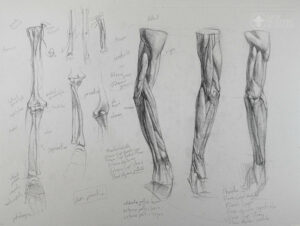- Lesson Details
- References
Now it is time to study the anatomy of the leg and arm. In the study of the leg and arm, we are going to focus on viewing the form from as many angles as possible, approaching the study almost like a sculpture. Because these are cylindrical, almost tubular structures with muscles that spiral, we simply won’t be able to understand how some of these muscles look without constantly turning the arm and the leg.
In this lesson, we will identify and draw the skeleton and muscles of the arm.
Students are encouraged to work from the NMA reference images and 3D viewer included on this page*.
Join Ukrainian-born artist Iliya Mirochnik as he passes on a 250-year-old academic method preserved at the Repin Academy in Saint Petersburg, Russia and seldom taught outside of the Academy and never before on camera.
The Russian Academic drawing and painting approaches were uninterrupted by the modern art movements that transformed representational art in the West, and as a result, they provide a unique and clear lineage to the greater art traditions of the past. As a powerful approach that is both constructive and depictive, it combines the two methods that prevail in contemporary representational art.
In these three drawing Courses, we have set out to condense the entire program, spanning over eight years into a logical, step-by-step procedure. We have made improvements and added resources and exercises to explicitly drive home the concepts that are required to work in this approach.
We have also structured the course so that it is not only useful for professional and experienced artists but also artists with no drawing experience whatsoever.
In the last part of our Russian Academic Drawing Course, Iliya brought together the knowledge we learned about the head and neck in order to complete a fully rendered portrait. In this next part, Figurative Anatomy, you will undertake a new challenge: the figure.
In order to draw the complexity of figure we need to study all the anatomy that makes up the surface form of the pelvis, ribcage, leg and arm.
The New Masters Academy Coaching Program directly supports this Course. If you enroll in the coaching program, you can request an artist trained in the Russian Academic Method including Iliya Mirochnik himself. Click here to enroll in the Coaching Program.
Materials
- Graphite pencils
- Kneaded and Hard Erasers
- Sanding Block
- Utility Knife
- Roll of Paper, Smooth Sketchbook paper
- Easel
- Light source
* Reference material is only available for premium subscriptions. If you don’t have premium access to the reference, you can pause the video when the reference is shown.

 UPDATE! October 1st, 2023: This version of the website will no longer receive updates. Please transition to the new website for the best experience.
UPDATE! October 1st, 2023: This version of the website will no longer receive updates. Please transition to the new website for the best experience. 













